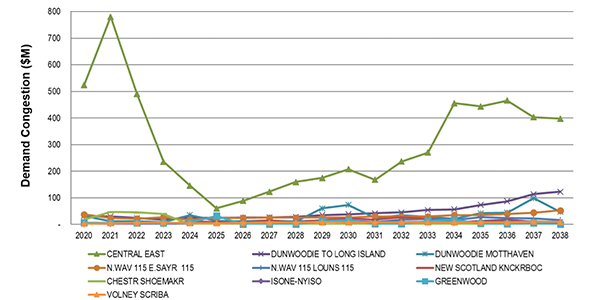NYISO’s Business Issues Committee on Wednesday approved manual revisions related to Tariff revisions submitted to FERC last month.
Michelle McLaughlin, senior settlements analyst, presented the revisions to the Revenue Metering Requirements Manual (RM2) and Meter Services Entity Manual. They reflect changes that allow market participants representing day-ahead demand response and demand-side ancillary services program resources to use meter services entities (MSEs) until those programs are eliminated in 2022.
NYISO’s distributed energy resources participation model permits an MSE to provide meter services and meter data services to responsible interface parties (RIPs), curtailment service providers (CSPs) and aggregators. (See NYISO OKs Changes on Hybrid, Fast Start Resources, TCCs.)
FERC in January 2020 approved Tariff changes permitting RIPs and CSPs to utilize MSEs for demand-side resources.
“In December we filed the Tariff modifications with FERC and we’re hoping to implement this in February as soon as the Tariff modifications become effective,” McLaughlin said.
Updating 2019 CARIS Database
NYISO must update and extend the 2019 Congestion Assessment and Resource Integration Study (CARIS) Phase 1 database for specific project evaluations under 2020 CARIS Phase 2 studies. It presented related material to stakeholders for discussion.
“The database itself will not differ much at all between what we have here and what we’ll have for the 2021 System Resource and Outlook study pursuant to the recent stakeholder-approved enhancements to the economic planning process,” Manager of Economic Planning Jason Frasier said. “The real change is more in the process, not so much in the underlying data.”
The ISO will soon file Tariff revisions to streamline its economic transmission planning and expand its scope to capture the grid’s ability to deliver energy from the future generation resource mix to the forecasted load. The changes rename the CARIS Phase 1 study to the System and Resource Outlook and double the assessment periods to 20 years. (See “OKs Economic Planning Changes,” NYISO Business Issues Committee Briefs: Dec. 9, 2020.)
“The changes expand the original 10-year timeframe of 2019 to 2028 to cover the next 10 years out to 2038,” Frasier said.
The 2020 CARIS Phase 2 base case will be used for evaluating specific Regulated Economic Transmission Projects (RETP) as required under the Tariff.
Senior planning engineer Chen Yang said key updates to New York Control Area (NYCA) generation status reflect the compliance plans generators submitted in response to the state’s Department of Environmental Conservation “peaker rule,” new NOx regulations that go into effect May 1, 2023. (See NY DEC Kicks off Peaker Emissions Limits Hearings.)
“It’s worth mentioning that the service pattern in the last two columns [on the right] — basically May 2025 to September 2025 and October 2025 to April 2026 — are repeated for the subsequent years in the CARIS study period,” Yang said.
NYCA network model assumptions include:
- Leeds Hurley system deliverability upgrade in-service in summer 2021;
- Cedar Rapids transmission upgrade in October 2021;
- L33P (Ontario PAR) out of service until January 2022, and then modeled back in service;
- Empire State Line Project/Western New York Public Policy Need project in-service in January 2022; and
- AC Tx Public Policy projects in service in January 2024.
NYCA generation key updates modeled status changes in compliance with the DEC peaker rule. | NYISO
Planners adjusted some dates because of software limitation, so the dates used for the study may not reflect actual, expected in-service dates.
Demand congestion would be reduced by the introduction of the AC transmission projects and associated upgrades starting in 2024, Yang said.
Any subsequent updates to the 2020 CARIS Phase 2 Base Case would be brought back to stakeholders for further review.





